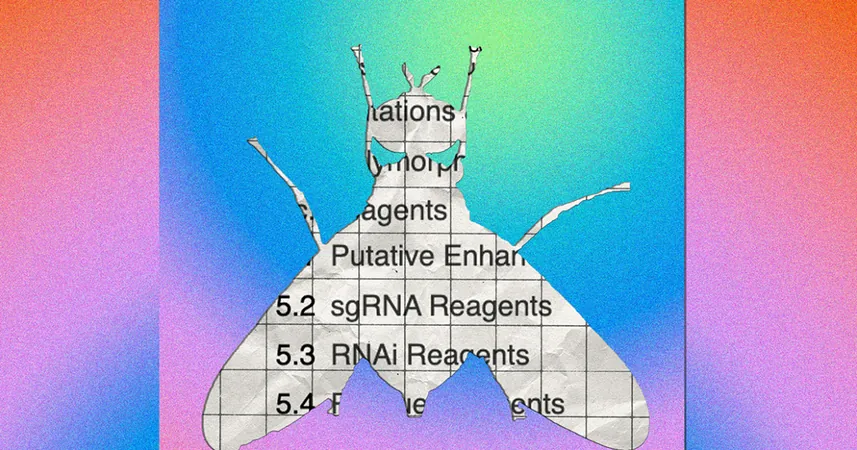
Trump's Harvard Cuts Put Essential Fruit Fly Database at Risk—The Global Implications
2025-09-15
Author: Ming
The Fruit Fly: A Tiny Hero in Biomedical Research
For over a century, the unassuming fruit fly has been an unsung hero in science, leading to groundbreaking discoveries that have changed our understanding of genetics and biology. This minuscule insect has revealed how X-rays induce genetic mutations and illuminated the way genes are inherited through chromosomes. Furthermore, the fruit fly has played a critical role in identifying how disruptions to certain genes can lead to jet lag and even severe neurological disorders.
The Importance of FlyBase
At the heart of these scientific advancements lies FlyBase, a vital online database that compiles nearly 90,000 studies on Drosophila melanogaster, the scientific name for the fruit fly. Researchers worldwide turn to FlyBase to design new experiments that investigate disease mechanisms and develop innovative treatments. The site garners around 770,000 page views every month from scientists devoted to creating personalized solutions for rare cancers, studying neurodegenerative diseases, and screening potential drug candidates for Alzheimer’s.
A Looming Crisis for FlyBase
Unfortunately, FlyBase is now facing potential layoffs and an uncertain future due to funding cuts from the Trump administration, specifically a $2.2 billion reduction in grants to Harvard University. This spring, the grant crucial for maintaining FlyBase was revoked, placing this essential resource at risk.
"I rely on FlyBase every single day; it’s absolutely essential," remarked Professor Celeste Berg from the University of Washington. She emphasized that much of what we understand about human genetics stems from studies conducted using fruit flies.
A Global Knock-on Effect
The impact of these cuts extends far beyond Harvard. With over 4,000 labs depending on FlyBase, the effects ripple through the global biomedical research community. The program, which has received federal support for over three decades, is crucial for ongoing research into gene functions and genetic development.
With Harvard receiving nearly $2 million annually to maintain FlyBase, the loss of funding has led to immediate staff reductions—two Harvard employees have already been laid off, with more cuts scheduled in the coming weeks.
Can FlyBase Survive?
Currently, efforts are underway to secure interim funding, but time is running out. If the essential staff members leave, rebuilding the expertise needed to maintain the database may become impossible. The recent order by a judge calling for the restoration of grant funding for Harvard researchers offers a glimmer of hope, but funding has yet to reach FlyBase.
The Future of Biomedical Research
As FlyBase seeks crowdfunding support and additional backing from academic institutions, the necessity to act swiftly has never been clearer. Researchers are pushing for a faster merger with the Alliance of Genome Resources, aiming to streamline genetic research and make findings more accessible.
Paul Sternberg, a prominent biologist, reinforces the urgency of these efforts. "When you’re losing staff, every moment counts," he stated. While FlyBase has planned to merge with the Alliance in 2029, the pressing financial needs could hasten this process.
Urgent Call to Action
As FlyBase currently seeks donations to reach its $1 million goal, the urgency for broader institutional support is paramount. Without the necessary funds, the future of this pivotal database remains bleak, potentially hindering scientific progress in understanding human health and genetics.
The fate of FlyBase is not just about one database; it’s about the future of biomedical research and the countless lives that depend on it. Our collective response will determine whether this critical resource can continue to light the way for future discoveries.



 Brasil (PT)
Brasil (PT)
 Canada (EN)
Canada (EN)
 Chile (ES)
Chile (ES)
 Česko (CS)
Česko (CS)
 대한민국 (KO)
대한민국 (KO)
 España (ES)
España (ES)
 France (FR)
France (FR)
 Hong Kong (EN)
Hong Kong (EN)
 Italia (IT)
Italia (IT)
 日本 (JA)
日本 (JA)
 Magyarország (HU)
Magyarország (HU)
 Norge (NO)
Norge (NO)
 Polska (PL)
Polska (PL)
 Schweiz (DE)
Schweiz (DE)
 Singapore (EN)
Singapore (EN)
 Sverige (SV)
Sverige (SV)
 Suomi (FI)
Suomi (FI)
 Türkiye (TR)
Türkiye (TR)
 الإمارات العربية المتحدة (AR)
الإمارات العربية المتحدة (AR)